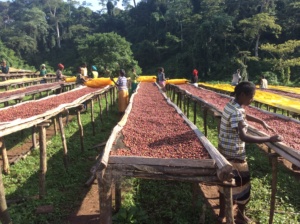Up to 60 percent of Ethiopia’s coffee production area could become unsuitable for coffee farming before the end of the century, says a new study. Moving coffee production to higher ground plus forest conservation and restoration could substantially increase the area suitable for coffee growing in Ethiopia, the study adds.

Scientists at the Royal Botanic Gardens, Kew and collaborators in Ethiopia have today published an innovative new study on the impact of climate change on coffee farming in Ethiopia. The research, conducted over a three-year period, investigated the potential for building a climate resilient coffee economy for Ethiopia.
The paper, recently published in Nature Plants, is called ‘Resilience potential of the Ethiopian coffee sector under climate change’.
Ethiopia is the world’s fifth largest coffee producer and Africa’s main exporter. In 2015/16, 180,000 metric tonnes of coffee at a value of US$800m was exported from the country, generating a quarter of the country’s export earnings and providing livelihoods for around 15 million Ethiopians.
Against a backdrop of rapidly increasing temperatures and decreasing rainfall, there was an urgent need to understand how climate change is influencing coffee production and what the options for the future are.
Justin Moat, co-leader of the study at Kew Gardens said: “This is the culmination of many years work, where we are trying to understand in detail the influence of climate change on coffee production in Ethiopia.
“We found that a ‘business as usual’ approach could be disastrous for the Ethiopian coffee economy in the long-term. Timely, precise, science-based decision making is required now and over the coming decades, to ensure sustainability and resilience for the Ethiopian coffee sector.”
In its wild state Arabica coffee (Coffea arabica) is a forest plant restricted to the highlands of Ethiopia and neighbouring South Sudan. It has been used in Ethiopia as a food and beverage for many hundreds, if not thousands, of years. Currently 80% of Ethiopia’s coffee comes from forests or forest-like habitats, and covers around 20,000km of the country’s landscape, with another 20% grown in small plots in sun or partial shade.










